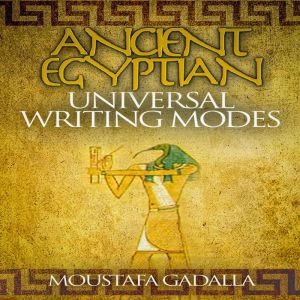

List: $19.95
| Sale: $13.97
Club: $9.97
Ancient Egyptian Universal Writing Modes
Author: Moustafa Gadalla
Narrator: Susie Hennessy
Unabridged: 17 hr 8 min
Format: Digital Audiobook Download
Publisher: Tehuti Research Foundation
Published: 05/22/2019
Categories: Nonfiction, Philosophy, Language Philosophy, History, Egyptian History
Synopsis
This book will show how the Egyptians had various modes of writings for various purposes , and how the Egyptian modes were falsely designated as "separate languages" belonging to others and how this one original language came to be called Greek, Hebrew, Arabic and other 'languages' throughout the world—through deterioration of sound values via 'sound shifts', as well as foreign degradation of the original Egyptian writing forms. The book is divided into seven parts with a total of 24 chapters, as follows: Part I. Denial, Distortion and Diversion has 3 chapters—Chapters 1 to 3: Chapter 1: The Archetypal Primacy of The Egyptian Alphabet shows the role and remote history of alphabetical letter-forms writing in Ancient Egypt prior to any other place on earth. Chapter 2: The Concealment of The Supreme Egyptian Alphabets will show the incredible western academia scheme to conceal the Ancient Egyptian alphabetical letter-forms from its prominent position in the history of writing. Chapter 3: The Diversion of A Proto-Sinaitic "Phoenician Connection" will uncover all the facts about having "Phoenicians" as the inventor of alphabets on an Egyptian soil! Part II. Formation and Forms of Egyptian Alphabetic Writings has 6 chapters—Chapters 4 to 9: Chapter 4: Genesis of Egyptian Alphabetic Letters/Writing Chapter 5: The Egyptian Sound Organization of Letters will cover the primary three vowels as the originators of all vowel sounds and associated consonants. Chapter 6: The Egyptian Alphabetic Writing Styles will sort out present common confusion of Ancient Egyptian styles of writing and set the two primary styles as uncials and cursive. Chapter 7: The Profession of Egyptian Scribes will cover the range of Egyptian writings; the profession of scribes; writing surfaces & instruments; etc Chapter 8: Multiple Writing Forms of a Single Document Chapter 9: Multiple Writing Forms of The Rosetta Stone Part III. How The One World Language Became The Many has five chapters—Chapters 10 to 14: Chapter 10: The Beacon of the Ancient World Chapter 11: Common Characteristics of Ancient Egyptian Alphabetic Writing System Chapter 12: Letter-forms Divergence of World Alphabets From Its Egyptian Origin Chapter 13: Sound Divergence of World Alphabets From Its Egyptian Origin Chapter 14: Cavalier Designations of New Languages will cover how a new language is awarded as a symbol of identity for winners of wars and new religions; etc Part IV. The Primary Linguistic Characteristics of The Egyptian Language has one chapter—Chapter 15: Chapter 15: The Primary Linguistic Characteristics of The Egyptian Language Part V. Out of Egypt—Diffusion Patterns To Asia and Africa has 5 chapters—Chapters 16 to 20: Chapter 16: Hebrew and Moses of Egypt Chapter 17: The Ancient Egyptian Hegemony of Asiatic Neighbors will discuss the found scripts in North and South Arabia; and clear up all apparent differences between them and the Ancient Egyptian writing system. Chapter 18: The African Connections Chapter 19: From Egypt To India and Beyond Chapter 20: From Egypt to The Black Sea Basin [Georgia & Armenia] will cover affinities of languages from Central Asia To the Black Sea Basin; etc Part VI. Out of Egypt—Diffusion Patterns To Europe has two chapters—Chapters 21 & 22: Chapter 21: Greek: A Shameless Linguistic Heist will cover the pre-existence of the proclaimed "Greek" alphabetical letter-forms in the Ancient Egyptian system; the absence of any linguistic distinction between Greek and the Ancient Egyptian language;etc Chapter 22: The European Languages will cover Etruscan, Latin and Hispanic languages; and the absence of any linguistic distinction between them and the Ancient Egyptian language. Part VII. The Ancient Future of The Universal Language has two chapters—Chapters 23 & 24: Chapter 23: Egyptian Alphabetical Vocalic Language [Past, Present & Future] Chapter 24: Renaissance & Seeking the Universal Language.